Supply Chain Issues
During the height of the pandemic when lockdown orders were in effect, there was a temporary pause on real estate and non-urgent construction projects. The introduction of remote work caused a lack of demand for corporate real estate prompting developers to let their supply dwindle. As we return to some normalcy, there are major strains on commercial real estate caused by supply chain issues.
Utah-based Merrill Sheriff Construction says they are seeing a delay in steel, door frames depending on wall thickness, PTO roofing, higher efficiency HVAC equipment, and glazing in certain materials.
Demand
The latest Ivry-Boyer Construction report says the total permit-authorized construction value in Utah in 2021 was $13.72 billion, an increase of 21.9 % over last year and a record. Residential construction value surged to a record $8.85 billion, surpassing 2020 by 30.4%. Nonresidential construction value reached $2.93 billion, the second-highest on record and an increase of 13.5% from the prior year. The additions, alterations, and repairs category experienced a decline for the first time since 2018, decreasing 1.5% from the record set in 2020. The decline resulted from a decrease in the residential sector, pushing the category’s total to $1.94 billion, the second-highest permitted value.
According to the Kem C. Gardner Institute of Politics at the University of Utah, new construction in Utah is back on the rise. Which agents at Mountain West Commercial Real Estate say is putting a strain on developers who simply do not have enough supply to meet the demand.
Construction management firm KGO says, about 30% of building materials imported to the U.S. come from China, making it construction’s biggest supplier.
The pandemic caused the global market for raw materials to slow down, resulting in contractors adding to the existing demand for locally distributed materials.
The total permit-authorized construction value in Utah in 2021 was $13.72 billion, an increase of 21.9 % over last year and a record. Residential construction value surged to a record $8.85.
Transportation
According to KGO, at the beginning of the pandemic, shipping companies cut their shipping schedule. Now, that demand is back to near pre-pandemic levels, shipping companies are playing catch up.
Containers have been arriving at ports in North America and Europe at an increasingly high volume, creating a heavy influx of ships that overwhelmed the availability of docks. At California ports like Los Angeles and Oakland, dozens of ships were forced to anchor out in the ocean for days before they could load and unload. At the same time, the labor shortage means fewer truck drivers and dock workers to unload goods, further slowing the process.
These delivery delays brought about by the pandemic have caused lead times to increase from as low as six weeks to as high as six months.
What the Future Holds
There will continue to be shortages across the board, from manufacturing to distribution, for at least the next two years. As supply chain issues unfold, smaller niche retailers will face more challenges in keeping their shelves stocked, as opposed to the large leading retailers who have access to different markets and products across the nation.
Consumers, on the other hand, will continue to demand faster delivery times than ever before. Customers expect coinvent and quick options, including same-day, next-day, and two-day delivery. This ultimately will drive companies to either increase their sitting inventory, real estate, and commercial real estate footprints or revolutionize their supply chains through having creative approaches when investing.
As for Utah, the increased and diverse construction to support ongoing real estate demand will continue. Salt Lake City’s strong infrastructure, geographical position and pro-business climate will continue to drive our economy in the short term. In the long-term, the diverse labor force, strong university systems and diverse economy will continue to make us a national powerhouse.





